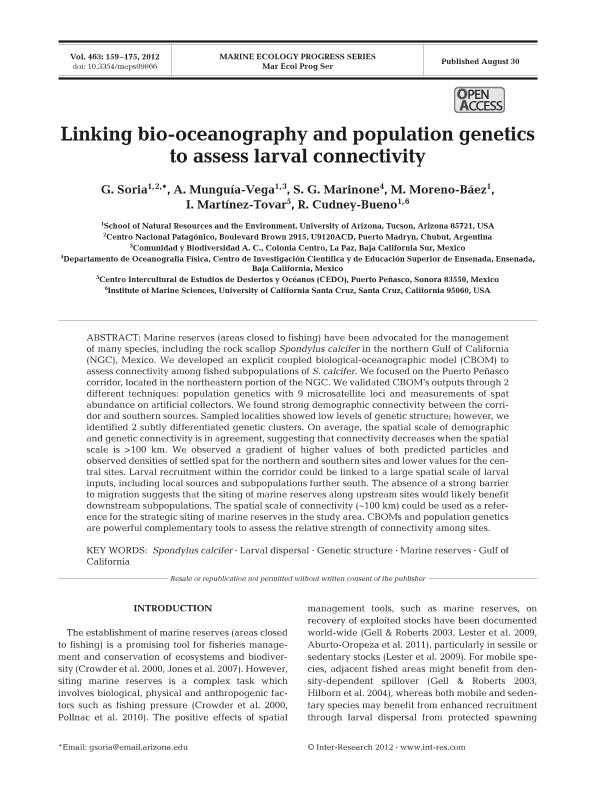Mostrar el registro sencillo del ítem
dc.contributor.author
Soria, Rodrigo Gaspar

dc.contributor.author
Munguía Vega, A.
dc.contributor.author
Marinone, S. G.
dc.contributor.author
Moreno Báez, M.
dc.contributor.author
Martínez Tovar, I.
dc.contributor.author
Cudney Bueno, R.
dc.date.available
2019-09-04T20:00:56Z
dc.date.issued
2012-08
dc.identifier.citation
Soria, Rodrigo Gaspar; Munguía Vega, A.; Marinone, S. G.; Moreno Báez, M.; Martínez Tovar, I.; et al.; Linking bio-oceanography and population genetics to assess larval connectivity; Inter-Research; Marine Ecology Progress Series; 463; 8-2012; 159-175
dc.identifier.issn
0171-8630
dc.identifier.uri
http://hdl.handle.net/11336/82918
dc.description.abstract
Marine reserves (areas closed to fishing) have been advocated for the management of many species, including the rock scallop Spondylus calcifer in the northern Gulf of California (NGC), Mexico. We developed an explicit coupled biological-oceanographic model (CBOM) to assess connectivity among fished subpopulations of S. calcifer. We focused on the Puerto Peñasco corridor, located in the northeastern portion of the NGC. We validated CBOM's outputs through 2 different techniques: population genetics with 9 microsatellite loci and measurements of spat abundance on artificial collectors. We found strong demographic connectivity between the corridor and southern sources. Sampled localities showed low levels of genetic structure; however, we identified 2 subtly differentiated genetic clusters. On average, the spatial scale of demographic and genetic connectivity is in agreement, suggesting that connectivity decreases when the spatial scale is >100 km. We observed a gradient of higher values of both predicted particles and observed densities of settled spat for the northern and southern sites and lower values for the central sites. Larval recruitment within the corridor could be linked to a large spatial scale of larval inputs, including local sources and subpopulations further south. The absence of a strong barrier to migration suggests that the siting of marine reserves along upstream sites would likely benefit downstream subpopulations. The spatial scale of connectivity (~100 km) could be used as a reference for the strategic siting of marine reserves in the study area. CBOMs and population genetics are powerful complementary tools to assess the relative strength of connectivity among sites.
dc.format
application/pdf
dc.language.iso
eng
dc.publisher
Inter-Research

dc.rights
info:eu-repo/semantics/openAccess
dc.rights.uri
https://creativecommons.org/licenses/by-nc-sa/2.5/ar/
dc.subject
Spondylus Calcifer
dc.subject
Larval Dispersal
dc.subject
Genetic Structure
dc.subject
Marine Reserves
dc.subject
Gulf of California
dc.subject.classification
Ecología

dc.subject.classification
Ciencias Biológicas

dc.subject.classification
CIENCIAS NATURALES Y EXACTAS

dc.subject.classification
Oceanografía, Hidrología, Recursos Hídricos

dc.subject.classification
Ciencias de la Tierra y relacionadas con el Medio Ambiente

dc.subject.classification
CIENCIAS NATURALES Y EXACTAS

dc.subject.classification
Conservación de la Biodiversidad

dc.subject.classification
Ciencias Biológicas

dc.subject.classification
CIENCIAS NATURALES Y EXACTAS

dc.title
Linking bio-oceanography and population genetics to assess larval connectivity
dc.type
info:eu-repo/semantics/article
dc.type
info:ar-repo/semantics/artículo
dc.type
info:eu-repo/semantics/publishedVersion
dc.date.updated
2019-07-15T14:57:01Z
dc.identifier.eissn
1616-1599
dc.journal.volume
463
dc.journal.pagination
159-175
dc.journal.pais
Alemania

dc.description.fil
Fil: Soria, Rodrigo Gaspar. University of Arizona; Estados Unidos. Consejo Nacional de Investigaciones Científicas y Técnicas. Centro Nacional Patagónico; Argentina
dc.description.fil
Fil: Munguía Vega, A.. University of Arizona; Estados Unidos. Comunidad y Biodiversidad A. C.; México
dc.description.fil
Fil: Marinone, S. G.. Centro de Investigación Científica y de Educación Superior de Ensenada. Departamento de Oceanografía Física; México
dc.description.fil
Fil: Moreno Báez, M.. University of Arizona; Estados Unidos
dc.description.fil
Fil: Martínez Tovar, I.. Centro Intercultural de Estudios de Desiertos y Oceanos; México
dc.description.fil
Fil: Cudney Bueno, R.. University of Arizona; Estados Unidos. University of California; Estados Unidos
dc.journal.title
Marine Ecology Progress Series

dc.relation.alternativeid
info:eu-repo/semantics/altIdentifier/url/http://www.int-res.com/abstracts/meps/v463/p159-175/
dc.relation.alternativeid
info:eu-repo/semantics/altIdentifier/doi/http://dx.doi.org/10.3354/meps09866
Archivos asociados
